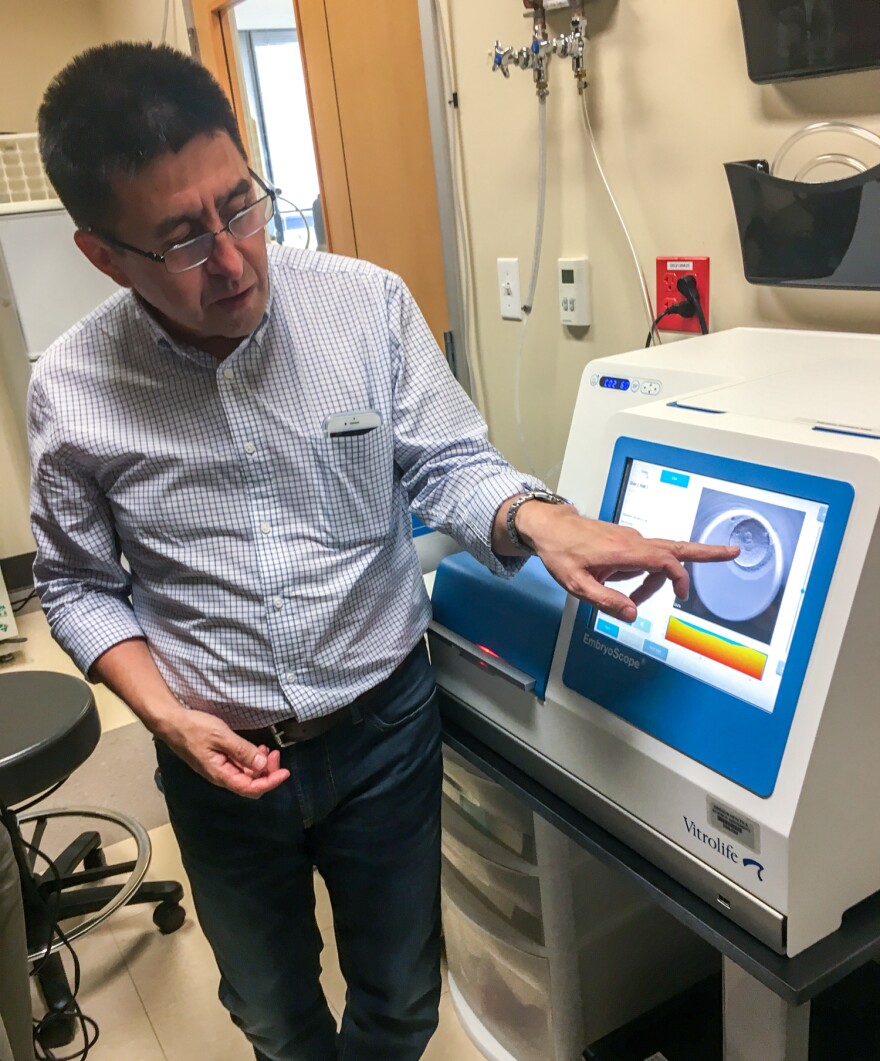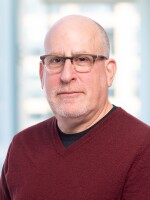From the thirteenth floor of a glass tower at the Oregon Health & Science University, you get a panoramic view of downtown Portland and the majestic mountains in the distance. But it's what's happening inside the building that's brought me here.
"Should we go do this thing?" lab manager Amy Koski asks.
She's just gotten a call from the fertility clinic three floors down. A woman undergoing in vitro fertilization has had her eggs extracted. One of the eggs is too immature to be used to try to create a baby, so she's donating it to research.
Koski grabs a small metal box and rushes to the elevator. It's her portable incubator.
"You want to keep the eggs very happy and warm," she says. "When you're jostling them and moving them, they get a little unhappy."
Human eggs are the key starting point for the groundbreaking experiments underway in this lab. It's run by Shoukhrat Mitalipov, a biologist who's been on the cutting edge of embryonic genetic research for decades.
Mitalipov and his international team electrified the world this summer when the group announced it had successfully — and seemingly safely — figured out how to efficiently edit the DNA in human embryos.
For the first time, they said, they had corrected a mutation that causes a potentially fatal heart condition. The hope is this landmark step could someday help prevent thousands of genetic diseases that have plagued families for generations.
Critics, however, pounced on the news. They fear editing DNA in human embryos is unsafe, unnecessary and could open the door to "designer babies" and possibly someday to genetically enhanced people who are considered superior by society.
As the debate raged last week, I asked Mitalipov if I could visit his lab to see the next round of his experiments. He wants to confirm his initial results and determine whether the method can be used to repair other mutations.
He agreed to a visit, and on Monday, I became the first journalist to see these scientists cross a line that, until recently, had been taboo.
A small room for big science
I've followed Mitalipov's research for years and have visited the labs of other scientists doing related work in Stockholm, London and elsewhere.
Still, I stepped into Mitalipov's embryology lab unsure of exactly what I was about to see and eager to better understand what allowed these scientists to succeed where others had failed.
"This is our small room, but that's where usually lots of big science happened," says Mitalipov, who was born in the former Soviet Union. "We believe this room is really magic in terms of science."

He points to a microscope where his colleague, Nuria Marti-Gutierrez, has just positioned a Petri dish. I'm able to watch everything she's doing on a computer screen.
Mitalipov points to a round silvery blob. It's the egg. "You can see it moving," he says.
Suddenly, a bunch of tiny ovals flit across the screen. They are sperm from a donor who has a genetic mutation that causes cardiomyopathy, a potentially fatal heart condition.
Marti-Gutierrez draws the sperm into a thin glass rod called a pipette. She then adds a microscopic gene-editing tool — a combination of chemical sequences known as CRISPR – that can make very precise changes in DNA.
In this case, CRISPR will zero in on the cardiomyopathy mutation to literally slice the defect in the DNA.
Finally, she pierces the shell of the egg with the pipette and injects the sperm and CRISPR. Almost before I know it's happening, it's done. A human embryo has been created and edited before my eyes.
"That's it?" I ask.
"Yep," Mitalipov says, chuckling to himself.
It was amazingly fast and seemingly easy — you could imagine a future where this sort of thing might become routine.
"This is how we do it," Mitalipov says matter-of-factly. He refers to the process as "DNA surgery."
Mitalipov and his team immediately do a second edit and then transfer the embryos to a larger incubator. The scientists will then spend the next few days monitoring live video of the two embryos, along with 17 others they had edited the weekend before, to see how they develop.
What's at work
Mitalipov thinks his team accomplished this feat by injecting the mutant sperm and the DNA editor into the egg at the same time. Previous attempts to edit DNA in human embryos were far less accurate and produced dangerous mutations elsewhere in the embryos' DNA.
Mitalipov and his colleagues are not sure exactly how it works. But they think that when CRISPR cuts the defective gene, the slice triggers the embryo to repair itself.
If future experiments confirm the results and show that the technique also works for other mutations, Mitalipov thinks the process could wipe out many diseases that have plagued families for generations, though he cautions that any practical application is still easily a decade or more away.
"[There are] about 10,000 different mutations causing so many different conditions and diseases," he says, pointing to Huntington's disease, cystic fibrosis and even possibly inherited forms of Alzheimer's and breast cancer.
"We're talking about millions of people affected. So I think the implications are huge," he says.
"I think this is a significant advance," says George Church, a Harvard geneticist. "This is important not only for parents who want to have healthy children, but more generally, it opens the door to preventative medicine where we can avoid a lot of painful genetic problems."
Skepticism, criticism and an ethical debate
While the results seem promising so far, there are still many questions. Some scientists remain skeptical that Mitalipov has really done what he says he's done.
"Unfortunately, the data do not allow the conclusion of correction for the embryos," says Dieter Egli, a biologist at Columbia University. "There are a number of other outcomes that are much more likely."
Mitalipov acknowledges that his work still needs to be reproduced by others, but he is confident his method is working.
Others are worried that less careful scientists might rush ahead too quickly and attempt to make babies before the technique has been proven to work and be safe.
"This is a strong statement that we can do genome editing," says George Daley, dean of the Harvard Medical School. "The question that remains is, 'Should we?' "
"I think it would be professionally irresponsible for any clinician to use this technology to make a baby," Daley adds. "It's just simply too early. It would be premature."
The idea of changing human DNA in ways that could be passed down for generations has long been considered off-limits. The fear is scientists could make mistakes and create new diseases that would persist for generations.
Some critics go so far as to say that scientists are essentially playing God by taking this step. They fear it will lead to parents picking and choosing the traits of their children. While that is not yet technically possible, critics say scientists are moving quickly toward that possibility.
"I think it's extraordinarily disturbing," says Marcy Darnovsky, who heads the Center for Genetics and Society, a watchdog group. "We'll see fertility clinics advertising gene editing for enhancement purposes. We'll see children being born who are said to biologically superior."
Mitalipov and his colleagues acknowledge the fears and agree the technique should be carefully regulated and only used for medical purposes. But, they argue, the fears should not stop the research.
"I don't think I'm playing God," Mitalipov says. "We have intelligence to understand diseases, eliminate suffering. And that's what I think is the right thing to do."
Copyright 2020 NPR. To see more, visit https://www.npr.org. 9(MDA5MTc0MDI0MDEzMzE4MjI4ODdlOTk4MA004))



